
Have you travelled to East of Turkey? Do you know that particular blue that hangs above you? How crispy the mornings are… How bright the sun shines… How green the meadows and plateau that all surround you… Endless visibility…. I love every inch of my country!
At Kars we were after grain and cheese, on a beautiful morning we had an hour trip to Boğatepe to witness the making of kaşar and gravyer – translates as gruyere but it is more like Emmantal as form and taste -. We were guests of İlhan koçulu; he is one of the warriors trying to sustain the traditional methods of cheese making, founding the first cheese museum in Turkey, Peynir Müzesi at Boğatepe Köyü, where the history of gravyer goes back to 1882. Although Kars had many types of cheese early years, now the most consumed ones are tulum, kaşar, gravyer and civil peyniri.
İlhan abi, is a cheese whisperer, he makes his gravyer talking to nature, following the time of the blossoms, air and earth decide the precise time to make the best cheese. The special cattle race and the fertile lands, herbs, flowers, around 200 variety of plants the cattles fed on, make their milk golden color with a distinctive fragrance and balanced in fat. Like any other mountain cheese in Europe İlhan Abi says.
Before we witnessed gravyer making, the experience started with a cheese makers’ breakfast; the scrapings of gravyer is cooked with clarified butter till they are golden broewn. Ilhan Abi teared one with his hand, pulling one side and he was pleased when he saw the melted amount of cheese, then he explained us that they do this to check the quality of the cheese if it has the right form and consistency, so thi sone has passed the test! There we were munching the hot cheese fritters, one bite and your mouth is filled with the taste of with clarified butter and the milky fresh cheese! Yes! Soon we learned that this was only the beginning of our endless homecooked meals that day!
Gravyer making is one laborious process, a process that contains strength, promptness, endurance against heat, fastness and above all common sense and experience. It starts with filtering the milk then fermentation, they use dry rennet obtained locally (if not they use a Swiss made one), şırdan mayası, -natural enzyme obtained from the stomach of young cows, used to curdle milk when making cheese- to make teleme, -the first curd-, then by using special long instrument called harbi, two usta cut the curd into rice size pieces, by kind of pulling and pushing harbi, they have to be very fast and have strong moves. Looks like this;
By the way, the gold and copper alloy pots make a huge difference on cheese making process. To understand if the cheese is ready to be taken out to cheesecloth and drained, one of the ustas dips his hand in the hot mixture -around 60°C- as if it was not hot, got some curd in his hand, squeezes and crumbles, checking if the pieces are the size of a rice grain.
Then it means it is ready to be drained, the heroic acts begins -well, it is their daily routine, but it is hero act if you ask me- they wrap the cotton cheese cloth’s –cendere- edges with a stainless string then in a glimpse of time you see this usta leans into the hot pot, soaking his hands in cheese to be, waist down! Whaaaaat?? I can tell by that time everyone of us was stunned, like children in a circus waiting the lion to chop the tamer’s head!
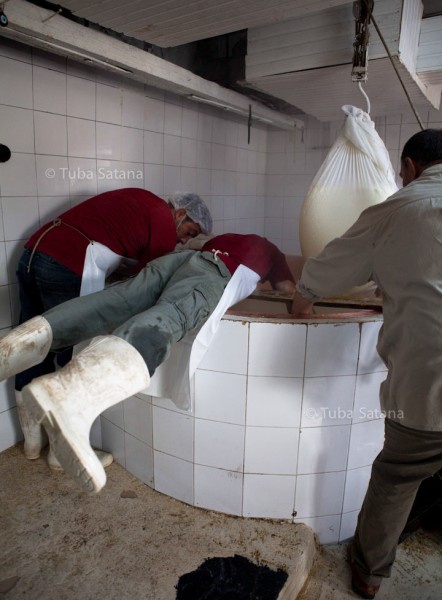
Drained cheese put in a tambour and pressed, then pressed down more with hands -yes it was hot- one usta presses out the cheese to get the water out, then he cools his hand by resting them in the cold water container awaiting!
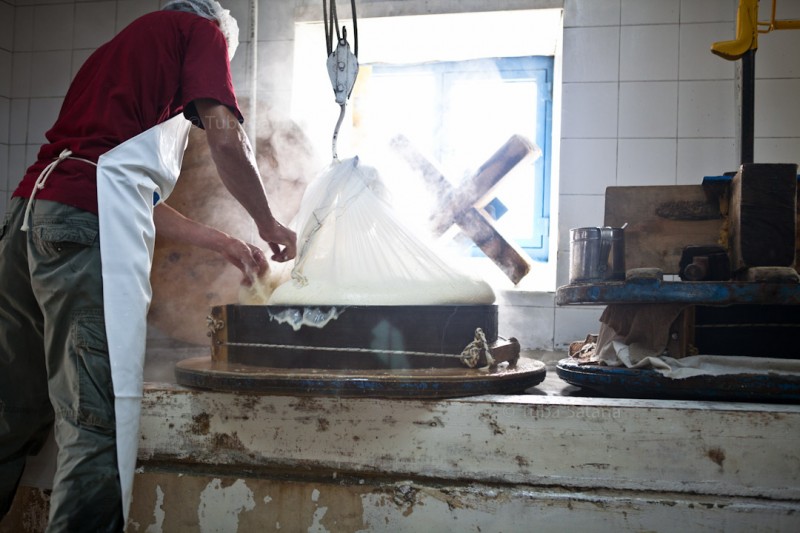
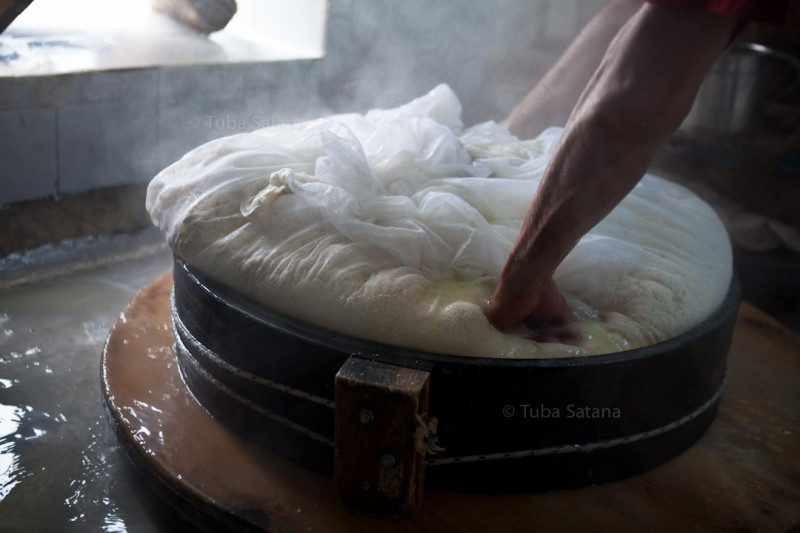
Then they turn the big wheel, and change the cheese cloth with a dry one. To get all the water out of the cheese, they put under weight starting with 500kg ending with 4 tons. Then comes the brining period where a local rock salt from Tuzluca, Iğdır is used. The brining period differ to the taste of the cities; the cheese that will be sold in Kars is left longest, where as in Istanbul, we have a mild salty taste.
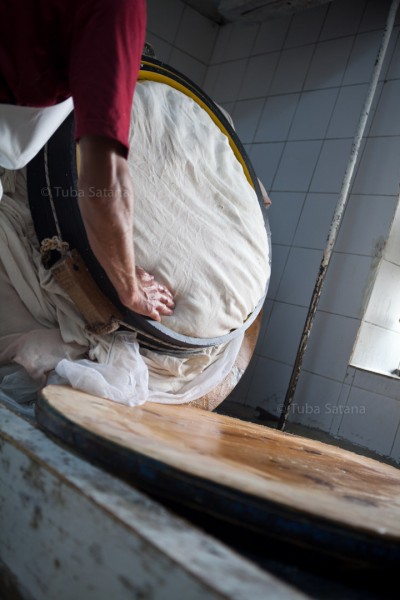
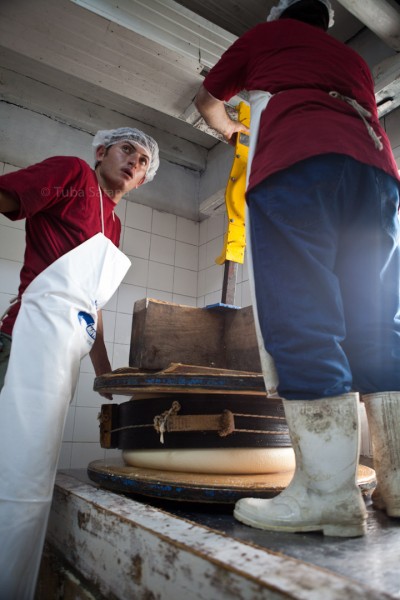
Then comes the hot room where they rest first before cold room. Almost like a sauna, it is around 28°C inside, where the usta turns the big wheels in its own axis everyday and turn it upside down every two days and they wipe their sweat. By then I understood why İlhan Abi always resembles Kars Gravyer to a baby; you have to feed, burp and change it, and it is more spoiled than a baby!
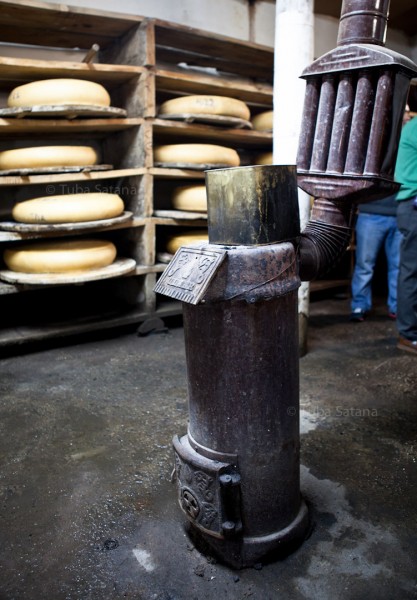 Then to the cold room, where maturing and ageing happens, it is around 8-14°C. Usta -the cheese monger- continues to turns and wipes them every often, salts them every three days and the cheese rest there almost 90-110 days…
Then to the cold room, where maturing and ageing happens, it is around 8-14°C. Usta -the cheese monger- continues to turns and wipes them every often, salts them every three days and the cheese rest there almost 90-110 days…

Never have guessed that much of intensity involved while making gravyer, it was not only the labour I am talking about but the passion of the cheesemongers, they were so self-confident, so caring, so attentive… They were after all, usta!
One deliberately prepared breakfast table was waiting us at Ilhan Abi’s house after sharing this experience with loved ones… Later a little promenade, may be a nap for some, we were happy to be there!
Ustaların ellerine sağlık!
p.s. you may read about gravyer making in Turkish from my article in Taraf newspaper, Buket’s experience here.
